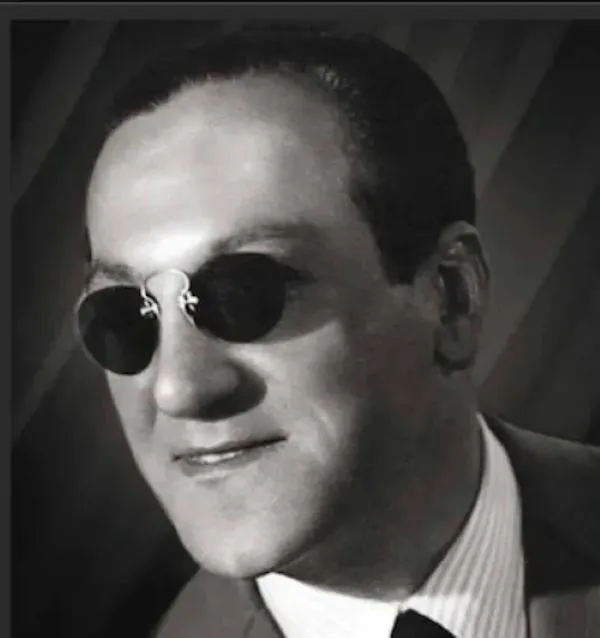
Carlos Di Sarli – El Señor del Tango
[Photo Credit: La Brujula 24]
If tango had a velvet voice, it would sound like Carlos Di Sarli. Known for his smooth, gliding style and dancer-first arrangements, he wasn’t just about elegance — he was about control. The man had taste, vision, and zero patience for musical nonsense.
Among dancers in the know, he’s often referred to simply as “El Señor” — not just out of respect, but as a kind of superstition. The idea being: if you say his name too casually before a tanda, you might jinx the magic. So in keeping with tradition (and a little reverence), we’ll just call him El Señor from here on out.
🕶️ Who was the man behind the sunglasses?
Well, first off — those sunglasses weren’t a style choice. El Señor lost sight in one eye when he was 13, after one of his brothers accidentally shot him in the face while playing with a gun. Wild, right? From that moment on, the glasses became part necessity, part mystery. On stage, he kept his cool, never showing too much. The sunglasses helped build that aura of distant elegance — the kind of presence that made you sit up straighter without knowing why.
🎼 Why did El Señor’s music stand apart from the rest?
He had a strict “no frills” policy. While other orchestras leaned into complex arrangements and bandoneón showmanship, El Señor banned flashy bandoneón riffs and kept things tight, melodic, and smooth. No showing off — just music that made sense to your body.
If D’Arienzo was like a strong cup of espresso and Pugliese was a glass of Malbec you sip slowly while thinking about your ex, then El Señor was your favorite old record player — warm, elegant, reliable, and low-key emotional.
🎧 How did his sound evolve over time?
In the 1930s, El Señor had more of a rhythmic punch — still elegant, but with sharper edges dancers could follow with their feet. By the 1940s and ’50s, though, things got deeper. His phrasing slowed down, the melodies stretched, and that signature tango "drag" showed up — the one that makes you feel like you're dancing underwater (in a good way).
His choice of singers evolved too, and here’s where it gets juicy:
Roberto Rufino (early 1940s): Young, dramatic, kind of a heart-on-your-sleeve type. Their music together has this bold edge.🎵 Song pick: “En un beso la vida"
Alberto Podestá (mid-1940s): Smooth as butter. His voice with El Señor’s phrasing is basically tango’s version of a love letter.🎵 Song pick: “Tu...el cielo y tu”
Carlos Florio (late 1940s): Less famous, but a perfect match for the silky vibe El Señor was leaning into.🎵 Song pick: “Como los nardos en flor”
Jorge Durán (late 1940s–50s): Brought drama and a bit of weight to the music. Some dancers found their combo extra theatrical.🎵 Song pick: “El ingeniero”
Mario Pomar (early 1950s): His voice brought a grounded, expressive quality and offered a smoother, emotionally restrained delivery that suited mid-century tango aesthetics.
🎵 Song pick: “Tormenta”Horacio Casares (mid-1950s): Elegant and understated his phrasing matched the maestro’s mature style — clear, poised, and deeply felt.
🎵 Song pick: “Hasta siempre amor”
El Señor’s choice to switch singers wasn’t driven by scandal — more likely it reflected his shifting artistic vision. He chose vocalists who could adapt to the mood and phrasing he wanted to build at that moment in his career.
🧐 Did he really quit his own orchestra?
Yep. True story: in the early 1930s, El Señor helped start a new orchestra with singer Santiago Devin. But when the style didn’t match his vision, he left and started again from scratch. He quit his own project! And started over from scratch. That’s how serious he was about getting things just right.
Later on — and here’s where the tea gets hot — there’s word that in the mid-1950s, some of his musicians walked out over pay issues. Delayed salaries, tension, who knows. Nothing formally confirmed, but it fits a broader pattern among tango bands of the time — and would explain shifts in his lineup and sound in his later years.
💿 What should I dance to if I want to feel El Señor?
Go with: Bahía Blanca. It’s named after his hometown and feels like a love letter to the past. Smooth, nostalgic, and emotionally rich. One of those tracks where nothing flashy happens — but everything feels.
"Tiene el perfume de aquellas noches..."
(It carries the perfume of those nights…)
Stay tuned as we spotlight more orchestras each month — the legends, the drama, and the sounds that keep us moving.
This post was brought to you by a mix of tango nerdery, insights from Horacio Godoy's musicality classes, late-night tanda debates, and a generous assist from ChatGPT (because let’s be honest, no one writes this stuff solo anymore).


